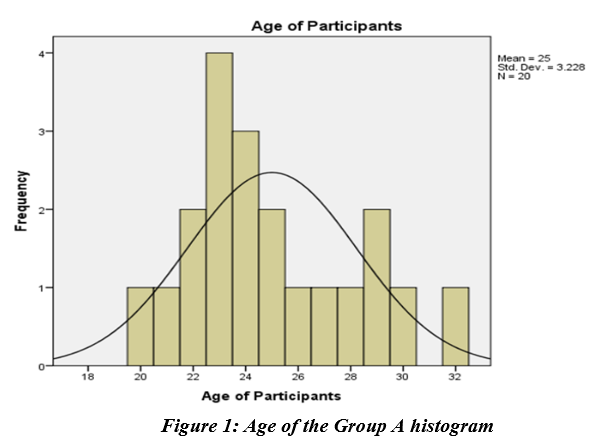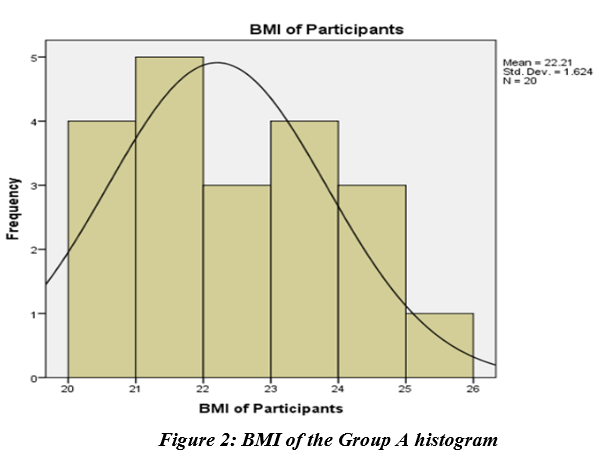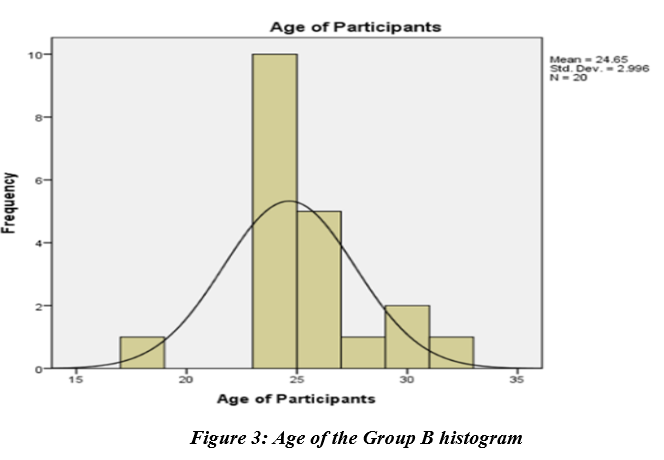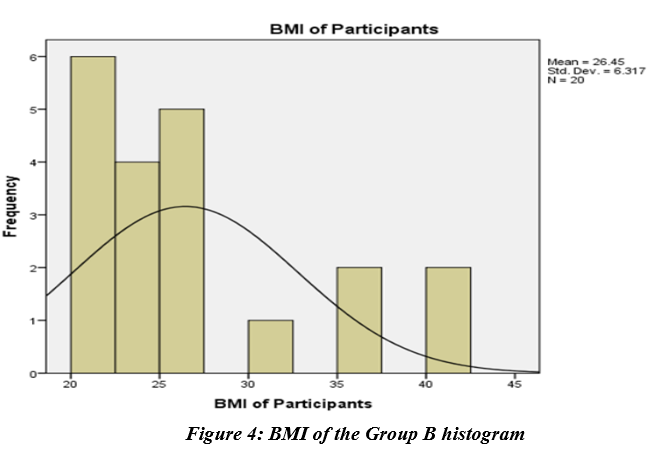Ayesha Karim1*, Saba Rafique2, Hafiza Neelam Muneeb3, Namra Saleem4
1*Lecturer, Allied Health Sciences Department, Lahore Institute of Science and Technology, Lahore, Pakistan![]()
2Senior Lecturer, RCRS Riphah International University, Lahore, Pakistan![]()
3Senior Lecturer, RCRS Riphah International University, Lahore, Pakistan![]()
4Physiotherapist, Sughra physiotherapy and poly clinic, Lahore, Pakistan![]()
ABSTRACT
Aims of Study: Premenstrual syndrome is a collection of physical and psychological symptoms; the aim of the study is to compare the effects of resistive exercises and stretching of core abdominal muscles on abdominal cramps in premenstrual syndrome.
Methodology: It was a Randomized Clinical Trial with a convenient sampling technique. Data was collected from 40 participants who had abdominal cramps before periods. Data were taken from Asaaf Hospital Johar Town Lahore in 6 months duration. The premenstrual syndrome questionnaire and Numeric Pain Rating Scale was used for each participant before and after treatment. Group A received resistive exercises and B received stretching exercises.
Results: This study concludes that resistive exercises that are bridging, crunches and planks are more effective than stretching exercises on abdominal cramps in premenstrual syndrome.
Limitations and Future Implications: This study was conducted during the COVID lockdown; it was hard to follow up with the participants. Also more studies should be done on the women who face abdominal pain while menstruating and not before menses.
Originality: All the authors mentioned participated in the study and it was originally conducted by them in Lahore.
Conclusion: To conclude, resistive exercises are more effective on abdominal muscles in reducing abdominal cramps in premenstrual syndrome as compared to stretching exercises.
Keywords: Abdominal cramps, menstruation, premenstrual syndrome, resistive exercise, female, luteal phase, follicular phase.

Introduction
Premenstrual syndrome is a collection of physical and psychological symptoms such as lower abdominal cramps, backache, abdominal bloating, mood swings, food cravings, skin breakouts and emotional disturbances beginning at least one or two weeks before menses start1. Mostly those women who are in their reproductive age are experiencing painful symptoms before their periods. Severity may differ woman to woman but most of the females are facing the indications of premenstrual syndrome. That is why more and more people are talking about it now and day by day research are being done to see the effect of premenstrual syndrome on the lives of women1.
There are around 47.8% women worldwide who are getting affected by PMS2. Exact cause of premenstrual syndrome is unknown, but some theories suggest that majority of the women or girls’ premenstrual syndrome is unknown, but some theories suggest that majority of the women or girls face the symptoms in the luteal phase of their menstrual cycle and this syndrome is activated by hormonal release and changes happening in menses3. PMS is diagnosed on the base of signs and symptoms it shows which makes this syndrome difficult to diagnose4.
Premenstrual syndrome is persistent worry to ladies during their conceptive lives and moderate to serious side effects sway on their nature of lives. Also, most of the research says that mostly symptoms faced in PMS are physical5. Almost 30-40% of women gets affected by the symptoms occurring in PMS sometime in their life which become hindrance in their work life as the physical symptoms such as abdominal cramps and bloating makes it difficult for the woman to work while experiencing such pain6. There is a physical as well as mental symptom in premenstrual syndrome and that is due to many reasons like increased stress hormones during PMS. Also, there is a great chance for the woman to have premenstrual syndrome in later reproductive age if she has experienced some sexual or emotional abuse in her early life. So, it is safe to say that those girls who face abuse whether emotional or physical during her teen years will be diagnosed with premenstrual syndrome later in their reproductive stage of the life7.
PMS not only comes with physical pain and bodily fatigue but also anxiety, depression, major mood changes and irritability like symptoms. Physical activity not only eliminates the pain like abdominal cramps and bloating but also it decreases the depression. Regular physical activity reduces despair and doing exercises increases the one’s self-confidence and leaves a positive image of own body which minimize the chance of having depression8,9. The effect of regular physical activity or exercises on the symptoms of premenstrual syndrome was seen in working women. Those females who made exercise part of their daily life felt less pain in periods. All other symptoms like back pain and digestion issues were also decreased in those females who did exercise habitually10.
Recent study revealed that Whole body vibrations had the same effect as resistive exercises on treating premenstrual symptoms in adolescents with PMS11. In agreement with this another evidence shows that combined program of resistive elastic exercise and consumption of fennel is remarkably effective for lessening some bodily and psychological symptoms associated with PMS12. Recently one study concludes that students who performed Pilates exercises which is also a type of resistive exercise experienced lesser PMS symptoms than those who didn’t.13 Meanwhile one research conducted in 2020 on effectiveness of abdominal stretching for treating PMS symptoms was determined. The study included teenagers with Premenstrual syndrome. It was reported that the PMS scale showed reduced results from a severe level to a medium level and later to a mild level in 70% participants. The study concluded that abdominal exercises like stretching can reduce the symptoms of premenstrual syndrome14.
It is also believed that swimming is also beneficial in reducing the physical and psychological symptoms of PMS15. One of the studies revealed that aerobic exercises are an effective intervention for treating the physical symptoms of PMS16. The rationale of this study was to compare the effects of resistive exercises and stretching on abdominal cramps in premenstrual syndrome. This study finds out the most effective technique for the relief of abdominal cramps and other symptoms of premenstrual syndrome that is resistive exercises or stretching. This not only opens gates for future researchers but also helps women health physical therapist to provide evidence based practice for women who have premenstrual syndrome.
Methodology
The study design was Randomized Clinical Trial. Convenient sampling technique was used. The study was conducted at Asaaf Hospital, Johar Town Lahore. The study duration was 6 months. Sample size of 40 participants was calculated by Epitool Inclusion criteria was females having abdominal menstrual cramps one week prior to their menses date with age group between 16-35 years having regular menses with body mass index >18.5kg/m2. Females with abdominal cramps due to any other reason except menses, received physical therapy session in last 3 months and those who rated their pain 0-3 on Numeric Pain scale rating were excluded11. Participants were divided equally into two groups randomly. Group A received abdominal resistive exercises (crunches, planks and bridging with 15 REPS and REST 10 SECS) and Group B received abdominal stretching exercises (Cobra Pose, CAT-COW stretch, and side straddle stretch with 10 seconds HOLD and 5 REPS) one week before their periods for 3 menstrual cycles. Premenstrual Syndrome Questionnaire (PMSQ) and Numeric Pain Rating Scale (NPRS) were the tools used on 1st session in 1st week and on last session in 12th week as pre and post treatment values, respectively. Participants filled the questionnaire 1 week before the menses and 1 week after the menses every time they filled it for complete consideration.
The data analysis was done by using SPSS version 25. For Descriptive Statistics Frequency tables and bar charts were used. Independent sample t-test was applied to measure difference between two groups. Paired t-test was applied to see the pre and post treatment difference in both groups.
Questionnaires
Premenstrual Syndrome Questionnaire (PMSQ)
This questionnaire is used in much recent research and a reliable questionnaire in terms of being simple and valid. Research was taken out on participants for this questionnaire, and it concluded that this tool is reliable and valid17.
Numeric Pain Rating Scale (NPRS)
There are many pain rating scales used in many studies however one study conducted to check the reliability and it concluded that this is scale is reliable to use18.
Results
Results showed that most of the females were in the age group of 20-25 years of age. BMI of most females was lying in the range of 22.6-26.5 kg/m2 Unlike Group B, 50% of group. Participants’ shows that they had complete relief in symptoms and marked 0 pain on NPRS as post treatment value. We applied independent sample t test to evaluate the statistical difference of post treatment results in two groups which showed us 0.00 p value of NPRS and 0.01 of abdominal cramps due to which we rejected our null hypothesis and accepted alternate hypothesis that is there is difference in effectiveness of resistive and stretching exercises in reducing abdominal cramps and pain in premenstrual syndrome.

This shows that the mean age of group A is 25 ± SD 3.22.

This shows that the mean BMI of group A is 22.21 ± SD 1.62.


Figure 3 shows that the mean age of group B is 24.65 ± SD 2.99.

Paired sample t test was used to check the difference of NPRS between pre and post intervention. After treatment results shows, group A 1.80 ± 0.616and group B was 0.75 ± 0.851with 0.000 p value which is statistically significant.

Paired sample t test was used to check the difference of abdominal cramps complains between pre and post intervention of groups. Here p value of 0.002 after treatment shows that there was a significant difference in pre and post values.

Paired sample t test was used to check the difference of Menstrual Backache between pre and post intervention of groups, p value of 0.005 in post treatment menstrual backache complain shows that there was a significant difference in pre and post values.
Discussion
The aim of the study was to compare the effects of resistive exercises and stretching of core abdominal muscles on abdominal cramps in premenstrual syndrome. In this study two groups were included; Group A was given resistive exercises treatment and Group B was given stretching exercises treatment. Post interventions results significantly showed improvement in group A which concluded that both types of treatment were beneficial but resistive exercises were more effective in reducing abdominal cramps in premenstrual syndrome.
Research conducted is in harmony with the current work that there is an impact of walking and aerobic exercise on physical symptoms of PMS that is backache and abdominal pain and cramps. Research participants were divided into 3 equal groups. 2 of them were experimental group: one group did brisk walking of 30 minutes regularly for 3 months. The other experimental group did aerobics for 30 minutes in 3 months. The results proved that pain and cramps significantly decreased at the end of first and third month of intervention (p=0.008, p=0.047) by both walking and aerobics19.
Another study conducted on influence of bridging exercise on abdominal muscle made an agreement with the research that bridging exercise which is a resistive exercise strengthens the muscles of abdomen and when the muscles are strong the pain is reduced. 30 participants were included in this study and there was a 6-week program of bridge exercise and the results showed considerable differences after 6 weeks of regularly performing bridging, the abdominal muscles got strong. Specially, Transversus abdominis muscle and internal oblique’s in static and dynamic lumber stability thickness increased statistically considerably as a result of the bridging exercise20.
One study accordant with this research was done in 2019 to see the effects on low back pain related with menses. 127 women were distributed in 2 groups, one was experimental group and other was control group. While the control group went with their normal work, the experimental group followed to the modified stretching exercise program. At one, fourth, eighth- and twelve-month questionnaires (VAS and Oswestry LBP disability index) were filled by the participants. Their results showed significant difference in before and after treatment pain score and disability21.
One study held in 2021 in Istanbul agrees with this recent research that even very light resistive type of exercise like Pilates can decrease the symptoms of premenstrual syndrome including abdomen cramps. 25 out of 50 participants performed Pilates and the other 25 did their daily regular activities, PMSS score of experimental groups toward the finish of activity was lower than their score got toward the start of activity and the difference was significantly important (p < 0.001). In this study, pilates movements were used, and it was observed that they significantly reduced PMS symptoms. In this respect, pilates exercises serve as essential for treating PMS symptoms12.
Maryam Kasraeian did a study in 2021 that agrees with this current research. Forty participants were distributed into 4 groups. One group consumed fennel, second group received resistant band training, 3rd group consumed fennel and did band training both, 4th one was control group. For eight weeks, elastic training was done in three periods of 45 minutes each. For two months, fennel was taken orally in the form of 30 droplets of 2% phenylene per day. The results indicated that the joint usage of both elastic training and fennel consumption had the most impact on physical symptoms of PMS22.
In previous research they compared the effects of aerobic exercise and yoga on Premenstrual syndrome in which total of 72 PMS sufferers were divided into two groups for PT treatment. Patients in Group A underwent aerobic activity, while those in Group B underwent 40-minute sessions of yoga three times a week for a month. The PMS Scale and the pain intensity (measured using the Visual Analog Scale) were assessed prior to, after 15 days of therapy, and one month later. By using paired t-tests, unpaired t-tests, and one-way ANOVA to analyze the data, it was determined that both aerobic exercise and yoga poses substantially decreased the severity of pain and PMS symptoms. It has been determined that yoga poses and aerobic exercise are equally successful in treating PMS, but yoga is better at reducing its symptoms than aerobic exercise23.
In recent study, checked the effects of stretching exercises and walking in premenstrual syndrome in which 25 women have premenstrual syndrome, according to the diagnosis. A week before the start of the menstrual cycle, 25 women between the ages of 14 and 30 who had been diagnosed with premenstrual syndrome were given stretching exercises and encouraged to walk for three months. Prior to beginning treatment, and again three months later, the premenstrual syndrome questionnaire was completed. The paired T-test was used for statistical analysis. Both physical and mental health used as outcome indicators. A significant difference was seen after the treatment of three months, according to the statistical analysis. The findings indicate that stretching exercises and walking help women’s physical and mental health while reducing premenstrual symptoms24.
In another study 62 people were chosen for the study. The subjects were split into two groups at random: 31 for yoga and 31 for control groups with blocks 4 and 6. The yoga group practiced yoga for ten weeks in three sessions, each lasting 60 minutes. The control group’s participants did not practice yoga. To assess the impact of yoga exercise on emotional, behavioral, physical symptoms, and quality of life in participants with PMS before and after the intervention, subjects filled out the Premenstrual Symptoms Screening Tool (PSST) questionnaire. Covariance was used to analyze the data. The findings show that yoga considerably lessens PMS symptoms and can be recommended as a PMS treatment25.
The previous research conducted on check the effect of Pilates Exercises versus Benson Relaxation Technique on Premenstrual Syndrome Symptoms. The 100 female students were chosen for the study. For data collection, two instruments were employed. Tool (I): simple data structures Schedule and instrument for interviews II Premenstrual Syndrome Scale (PMSS). The high PMS score demonstrates the severity of the symptoms. For two months, the study group participants were required to perform the Pilates movements and the Benson relaxation technique. Premenstrual syndrome symptoms in the experimental groups were identified at the end of the two months, and the impact of interventions on PMS was assessed. The conclusion was compared to Benson relaxation approach, Pilate’s activities were more successful at reducing the somatic, behavioral, and psychological signs and symptoms of PMS26. All the mentioned research and studies have shown somehow effects of exercise on premenstrual syndrome. Some studies have used stretching exercises as an intervention and some have used resistive and other exercises but none of the research have compared resistive exercises with stretching to see the effects on the symptoms of premenstrual syndrome. This research compares the effect of resistive and stretching both on abdominal cramps faced during premenstrual syndrome and most of the women.
Conclusion
This study concludes that resistive exercises are more effective on abdominal muscles in reducing abdominal cramps in premenstrual syndrome as compared to stretching exercises. Stretching exercises are also beneficial but resistive are more effective.
Recommendations
- Sample size should be increased
- Quick and long haul impact should be assessed
- Further research can be conducted on pain relief related to menstrual cycle as this is affecting many young women using advanced techniques.
Study should also be done on the women who experience pain while menstruating not before menses date.
AUTHORS’ CONTRIBUTION:
The following authors have made substantial contributions to the manuscript as under:
Conception or Design: Ayesha Karim
Acquisition, Analysis or Interpretation of Data: Ayesha Karim
Manuscript Writing: Ayesha Karim and Namra Saleem
Approval: Saba Rafique and Hafiza Neelam Muneeb
All authors acknowledge their accountability for all facets of the research, ensuring that any concerns regarding the accuracy or integrity of the work are duly investigated and resolved.
ACKNOWLEDGEMENTS: None
INFORMED CONSENT: Consent was taken from participants.
CONFLICT OF INTEREST: The authors have no conflict.
FUNDING STATEMENTS: No fund was required.
ETHICS STATEMENTS: The protocol of the present study was registered by the Institutional Review Board (IRB) of Riphah International University Lahore ethical approval was taken for current study (IRB reference # F19C14G40018).
References
- Chumpalova P, Iakimova R, Stoimenova-Popova M, Aptalidis D, Pandova M, Stoyanova M, et al. Prevalence and clinical picture of premenstrual syndrome in females from Bulgaria. Annals of general psychiatry. 2020;19(1): pp 1-7.
- Gudipally PR, Sharma GK. Premenstrual syndrome. StatPearls [Internet]: StatPearls Publishing; 2022 Jul 18.
- Rapkin AJ, Akopians AL. Pathophysiology of premenstrual syndrome and premenstrual dysphoric disorder. Menopause international. 2012;18(2): pp 52-59.
- Zehravi M, Maqbool M, Ara I. Unfolding the mystery of premenstrual syndrome (PMS): an overview. International Journal of Adolescent Medicine and Health. 2022 Sep 19.
- Dennerstein L, Lehert P, Heinemann K. Epidemiology of premenstrual symptoms and disorders. Menopause international. 2012;18(2): pp 48-51.
- Baker L, O’Brien P. Premenstrual syndrome (PMS): a peri-menopausal perspective. Maturitas. 2012;72(2): pp 121-125.
- Bertone-Johnson ER, Whitcomb BW, Missmer SA, Manson JE, Hankinson SE, Rich-Edwards JW. Early life emotional, physical, and sexual abuse and the development of premenstrual syndrome: a longitudinal study. Journal of women’s health. 2014;23(9): pp 729-739.
- Eyre HA, Papps E, Baune BT. Treating depression and depression-like behavior with physical activity: an immune perspective. Frontiers in psychiatry. 2013 Feb 4; 4: pp 3.
- Zamani Sani SH, Fathirezaie Z, Brand S, Pühse U, Holsboer-Trachsler E, Gerber M, et al. Physical activity and self-esteem: testing direct and indirect relationships associated with psychological and physical mechanisms. Neuropsychiatric disease and treatment. 2016: pp 2617-2625.
- Tsai S-Y, Kuo F-C, Kuo H-C, Liao L-L. The prevalence of self-reported premenstrual symptoms and evaluation of regular exercise with premenstrual symptoms among female employees in Taiwan. Women & Health. 2018;58(3): pp 247-259.
- ElDeeb AM, Atta HK, Osman DA. Effect of whole body vibration versus resistive exercise on premenstrual symptoms in adolescents with premenstrual syndrome. Bulletin of Faculty of Physical Therapy. 2020;25: pp 1-6.
- Çitil ET, Kaya N. Effect of pilates exercises on premenstrual syndrome symptoms: a quasi-experimental study. Complementary therapies in medicine. 2021;57: pp 102623.
- Kucukkelepce DS, Unver H, Nacar G, Tashan ST. The effects of acupressure and yoga for coping with premenstrual syndromes on premenstrual symptoms and quality of life. Complementary Therapies in Clinical Practice. 2021;42: pp 101282.
- ROHMAH YKM, Mukhoirotin M. Abdominal stretching to reduce premenstrual syndrome: a case series. Medisains (Jurnal Ilmiah Ilmu-Ilmu Kesehatan). 2020;18(1): pp 37-40.
- Maged AM, Abbassy AH, Sakr HR, Elsawah H, Wagih H, Ogila AI, et al. Effect of swimming exercise on premenstrual syndrome. Archives of gynecology and obstetrics. 2018;297: pp 951-959.
- Mohebbi Dehnavi Z, Jafarnejad F, Sadeghi Goghary S. The effect of 8 weeks aerobic exercise on severity of physical symptoms of premenstrual syndrome: a clinical trial study. BMC women’s health. 2018;18(1): pp 1-7.
- Takeda T, Yoshimi K, Yamada K. Psychometric testing of the premenstrual symptoms questionnaire and the association between perceived injustice and premenstrual symptoms: a cross-sectional study among Japanese high school students. International Journal of Women’s Health. 2020: pp 755-763.
- Alghadir AH, Anwer S, Iqbal A, Iqbal ZA. Test–retest reliability, validity, and minimum detectable change of visual analog, numerical rating, and verbal rating scales for measurement of osteoarthritic knee pain. Journal of pain research. 2018: pp 851-856.
- Yekke Fallah L, Azimi H, Sadeghi T. The Effect of Aerobic and Walking Exercise on Physical and Psychological Symptoms and Pain of Premenstrual Syndrome. Iran Journal of Nursing (2008-5923). 2013;25(80).
- Khanjari S, Oskouie F, Eshaghian Dorche A, Haghani H. Quality of life in parent of children with leukemia and its related factors. Iran Journal of Nursing. 2013;26(82): pp 1-10.
- Chen H-M, Hu H-M. Randomized trial of modified stretching exercise program for menstrual low back pain. Western Journal of Nursing Research. 2019;41(2): pp 238-257.
- Kasraeian M, Esmaielzadeh F, Hozhabrian G, Shadmehri S, Kazemi N. Effects of an Eight-week Elastic Training and Foeniculum Vulgare Consumption on Premenstrual Syndrome in Adolescent Girls: a Randomised Clinical Trial. Women’s Health Bulletin. 2021;8(2): pp 72-82.
- Vaghela N, Mishra D, Sheth M, Dani VB. To compare the effects of aerobic exercise and yoga on Premenstrual syndrome. Journal of education and health promotion. 2019;8.
- Sureshkumar S. The Effects of stretching exercises and walking in premenstrual syndrome. Journal of Pharmaceutical Negative Results. 2022: pp 715-722.
- Kamalifard M, Yavari A, Asghari-Jafarabadi M, Ghaffarilaleh G, Kasb-Khah A. The effect of yoga on women’s premenstrual syndrome: A randomized controlled clinical trial. International Journal of Women’s Health and Reproduction Sciences. 2017;5(3): pp 205-211.
- Hassan Ahmed A, Mohamed Hassan N, Hassan Shamekh A, S Badawy A. Effect of Pilates Exercises versus Benson Relaxation Technique on Premenstrual Syndrome Symptoms. Egyptian Journal of Health Care. 2022;13(2): pp 39-53.
The Ziauddin University is on the list of I4OA, I4OC, and JISC.
This is an open- access article distributed under the terms of the Creative Commons Attribution License (CC BY 4.0).
